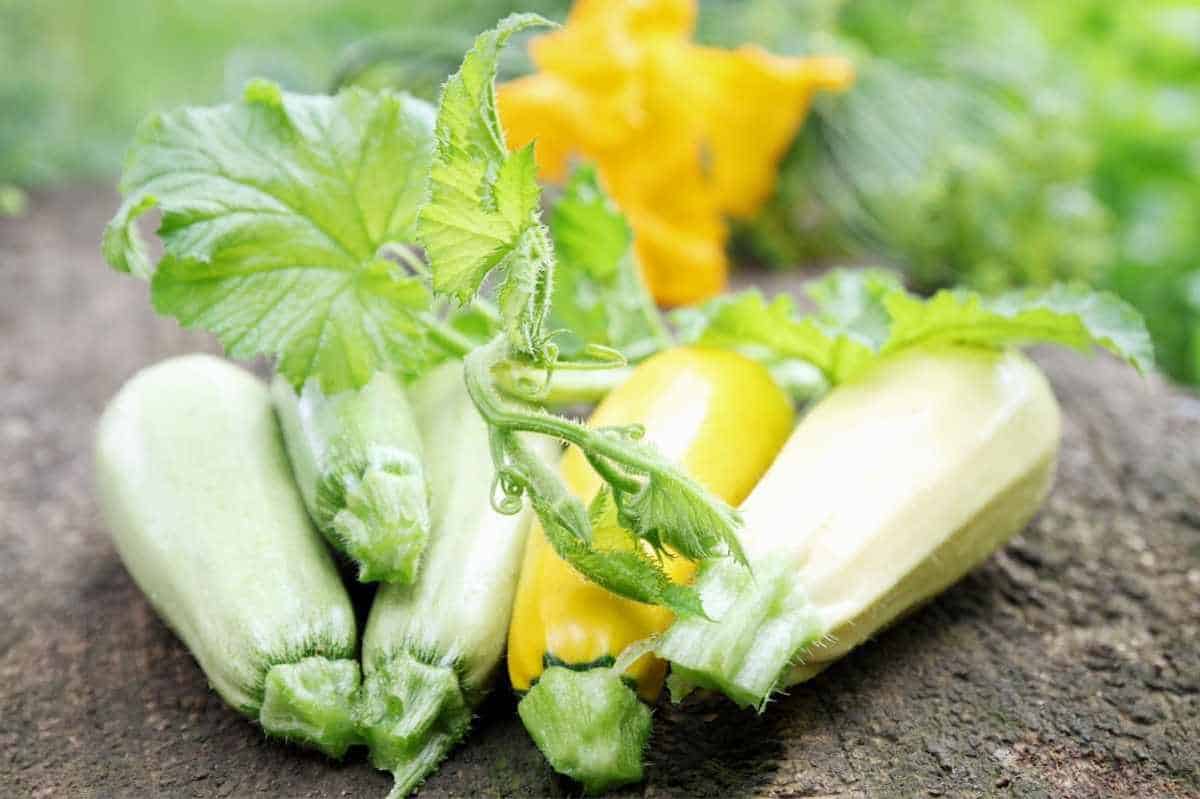Download Printable Zucchini and Summer Squash Growing Guide »
Few veggies are as prolific as zucchini and summer squash in the summer vegetable garden! There is a reason August 8th is National Sneak Zucchini on Your Neighbor’s Porch Day—with the right growing conditions, you can have so much zucchini you just have to share.
While we’re mostly going to talk about zucchini here, it’s important to note that zucchini is just one type of summer squash, and they all have the same growing conditions. So no matter if you’re looking to grow traditional green zucchini, yellow crookneck squash, or a rare heirloom summer squash—everything in this guide will apply. Let’s get growing!
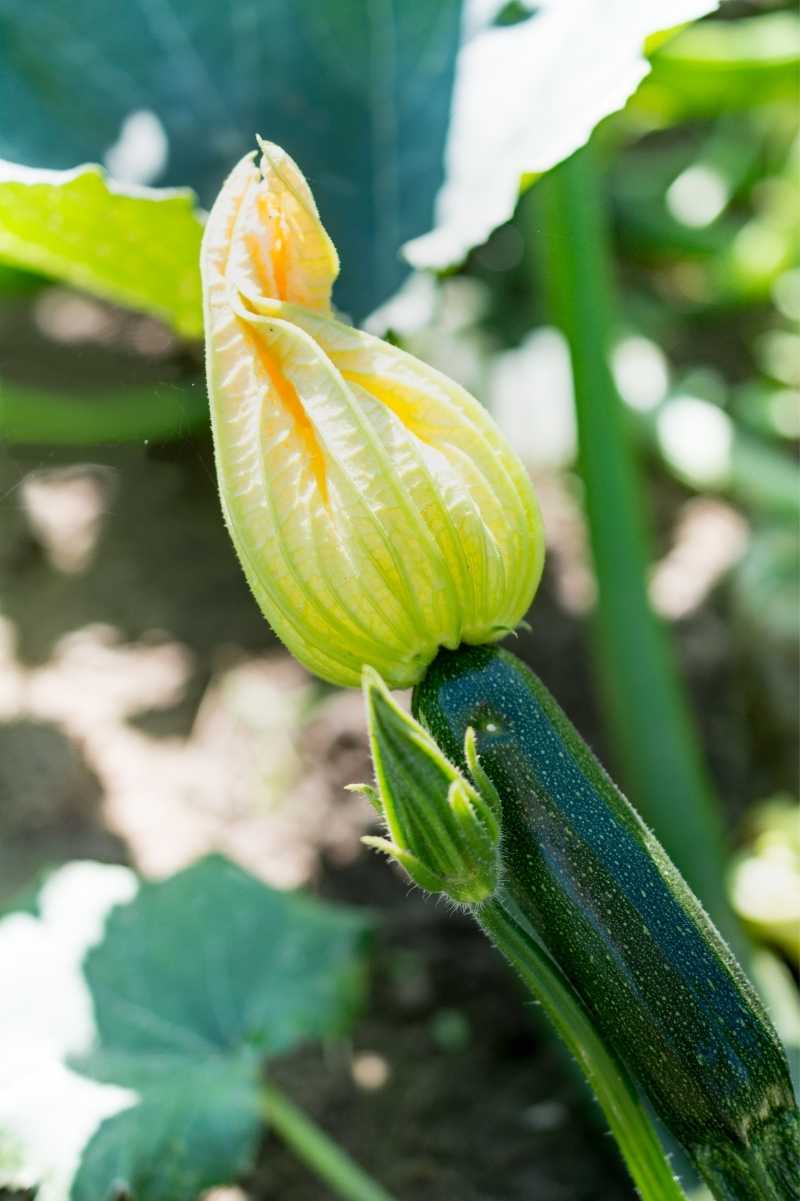
Table of Contents
Is growing zucchini easy?
Yes! Zucchini easily produces an overabundance of fruit throughout the growing season. For many folks, the biggest problem you’ll have growing zucchini is having so many you don’t know what to do with them. Zucchini doesn’t require any special treatment. As long as you have rich soil and water frequently, growing zucchini will be an easy beginner gardening project.
The one caveat here: pesky bugs. Like many other cucurbit family members, zucchini and other summer squash are favorites of squash bugs and squash vine borers that can decimate your zucchini crop. The good news comes in two parts: 1) there are some methods to keep these pests at bay that we’ll cover down below, and 2) zucchini and summer squash are so prolific that even if you do get a pest infestation, you’ll probably have already harvested dozens and dozens of squash before the plant stops producing. Yay for zucchini!
Does zucchini need full sun?
Yes! Zucchini does best in a location that gets six to eight hours of sunlight a day. Without this light, your zucchini plant may grow long, thin vines and pale yellow leaves, affecting the number of zucchini your plant will produce.
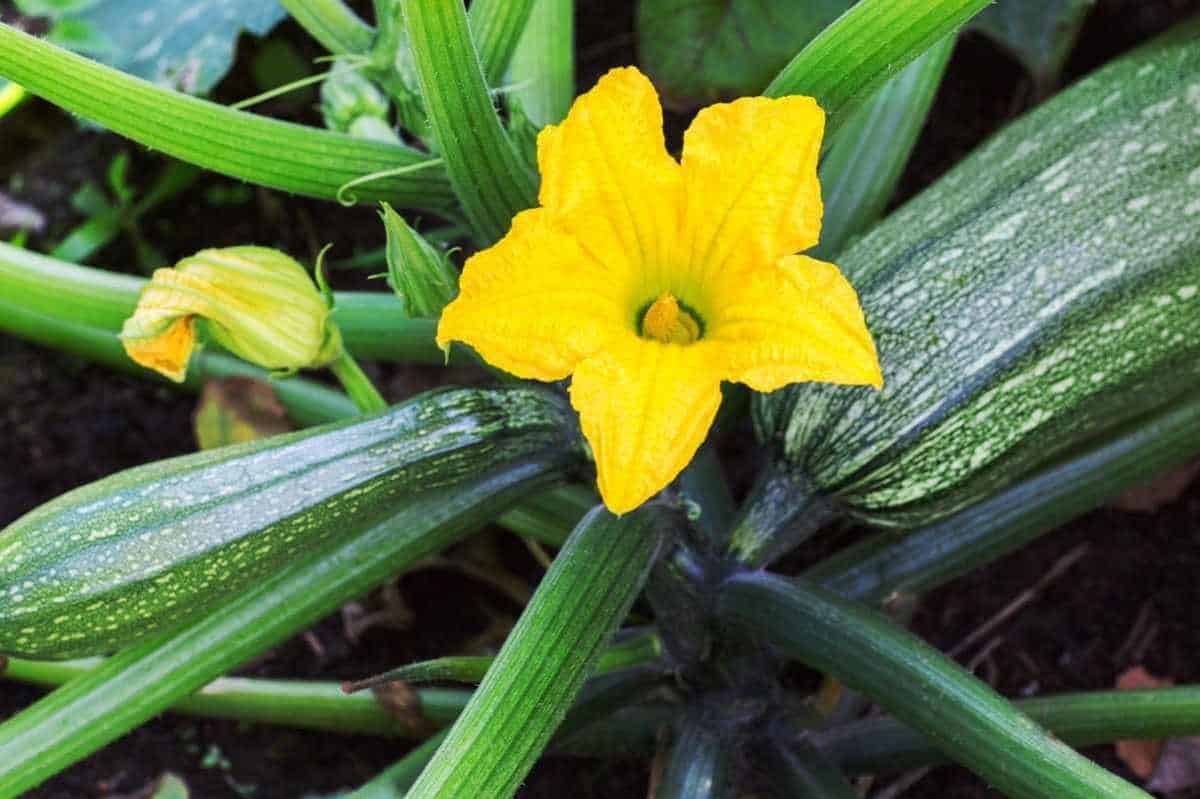
What’s the difference between zucchini and summer squash?
Some folks use the terms interchangeably, but it’s best to think of summer squash as the broader category, and zucchini is just one type of summer squash. When we think of zucchini, we’re typically thinking of squash that is long, cylindrical, smooth-sided, and dark green, but you’ll see all kinds of colors, shapes, and sizes listed in the seed catalog as “zucchini.” It all works out, though—all zucchini and summer squash have roughly the same growing habits, taste, and use in the kitchen. So whatever you grow, it’ll work!
Varieties of zucchini and summer squash
There are hundreds of zucchini and summer squash varieties to choose from. The majority of zucchini are compact bush zucchini; however, some types of zucchini and summer squash can grow on long vines similar to their winter squash cousins. Here are some varieties to try in your garden:
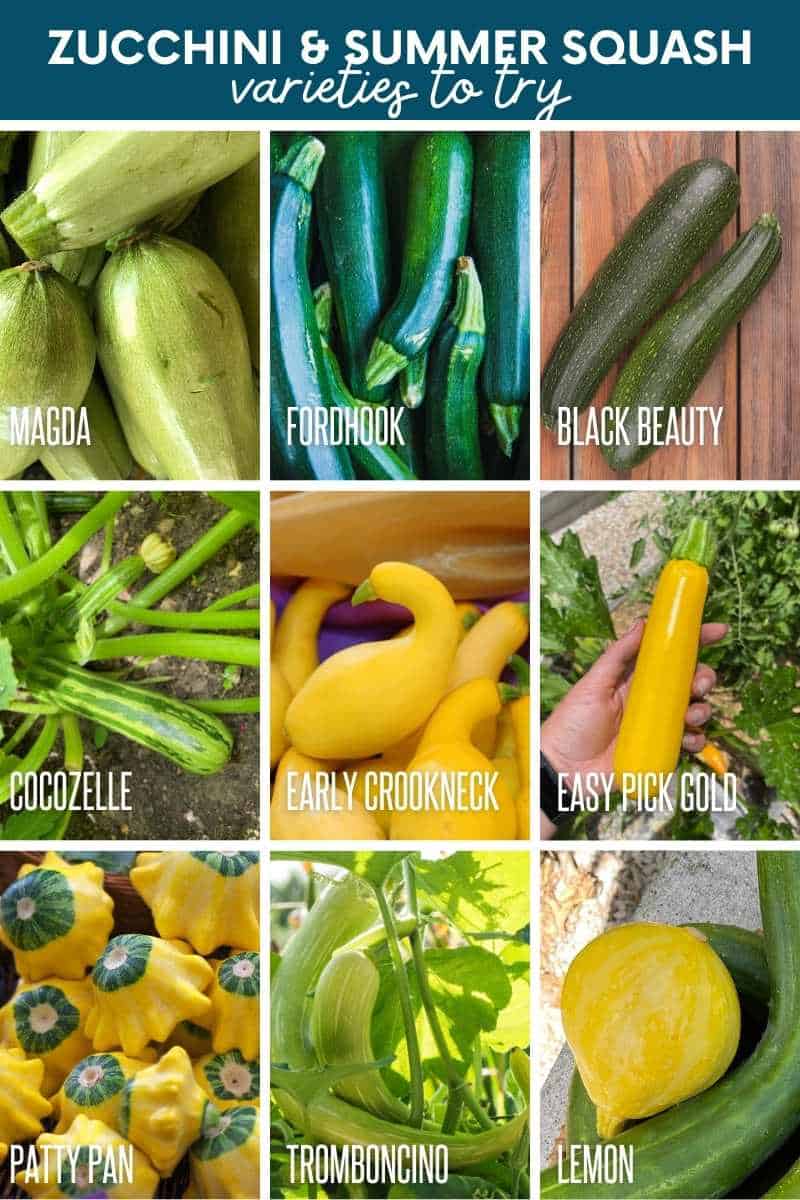
Traditional Bush Zucchini
- Magda—This short and stocky pale green zucchini (known as a “cousa zucchini”) is commonly grown in the Middle East. You pick them small—about 3-4″ in length—making them great for stuffing.
- Fordhook—This is a classic dark green, cylindrical zucchini. We’ve had great luck freezing zucchini from this variety!
- Black Beauty—Another classic zucchini, this is basically what you’ll get if you pick up zucchini from the grocery store.
- Cocozelle—These green striped zucchini have shown decent squash bug resistance—and their fun striped skin is an exciting addition to the dinner table!
Bush Summer Squash
- Early Crookneck—Every garden needs a good yellow squash, and the benefit of these is that these will be the last cucurbit variety that squash bugs choose to eat. So if you fight squash bugs each year, a crookneck plant or two might get you squash later than you usually would.
- Easy Pick Gold—These smooth-sided, straight yellow squash are wonderful because the plants are spineless—no scratched up hands and arms when you harvest! This makes them an excellent option for kids to grow.
- Pattypan (many varieties)—These flower-shaped squash may look like they’d be a hard-shelled winter squash, but they have tender skin and flesh just like your favorite zucchini. There are dark green, light green, yellow, white, and speckled pattypan squash to choose from.
Vining Summer Squash and Zucchini
- Tromboncino—This Italian heirloom creates huge plants with giant, curvy squash. Due to its solid stems, this variety does a good job resisting Squash Vine Borer damage.
- Lemon—This is a must-grow every year in the Growfully Gardens! These vast, sprawling plants are the most prolific summer squash plant we’ve ever seen (and that’s saying something). Each plant produces hundreds of squash that are the size, shape, and color of large lemons. They are tender, sweet, and perfect for grilling. We’ve had good luck with avoiding squash bugs with this variety, as well!

What is the best zucchini and summer squash to plant?
You’ll find Fordhook zucchini, Early Crookneck summer squash, and Lemon summer squash in our garden every year. The best variety for your microclimate might be different, but these are our favorites in Zone 6B.
Growfully Protip
The best way to figure out what varieties perform well in your area? Ask around! Find a neighbor with a good garden, email your local Master Gardener’s group, ask the folks at your Mom and Pop hardware store—or my personal favorite—make friends with the old-timers in your area—they are a wealth of knowledge!
Should I start my zucchini indoors?
Zucchini doesn’t take long to grow—only 35-55 days for certain varieties—so it’s unnecessary to start your zucchini indoors for most folks. Like most summer and winter squash, the roots of zucchini plants are tender, and they tend not to transplant well.
If you live in a cooler climate (or just really want to get a jump start on your zucchini), you may still choose to start the seeds indoors. Start them three or four weeks before you plan on transplanting them. Grow them in large pots—four inches is ideal—to help avoid the risk of transplant shock. Plant three seeds to a pot, then snip off the base of the two weakest plants, leaving the strongest intact.
A week or so before transplanting, harden off your zucchini plants by setting them outside in a sheltered area for more and more time each day to get used to outdoor conditions.
Growfully Protip
If you decide to start your zucchini plants indoors, we recommend using a pot that will keep the root disturbance low when transplanting. Peat pots, manure pots, newspaper pots, or soil blocks all work!
How to start zucchini seeds indoors
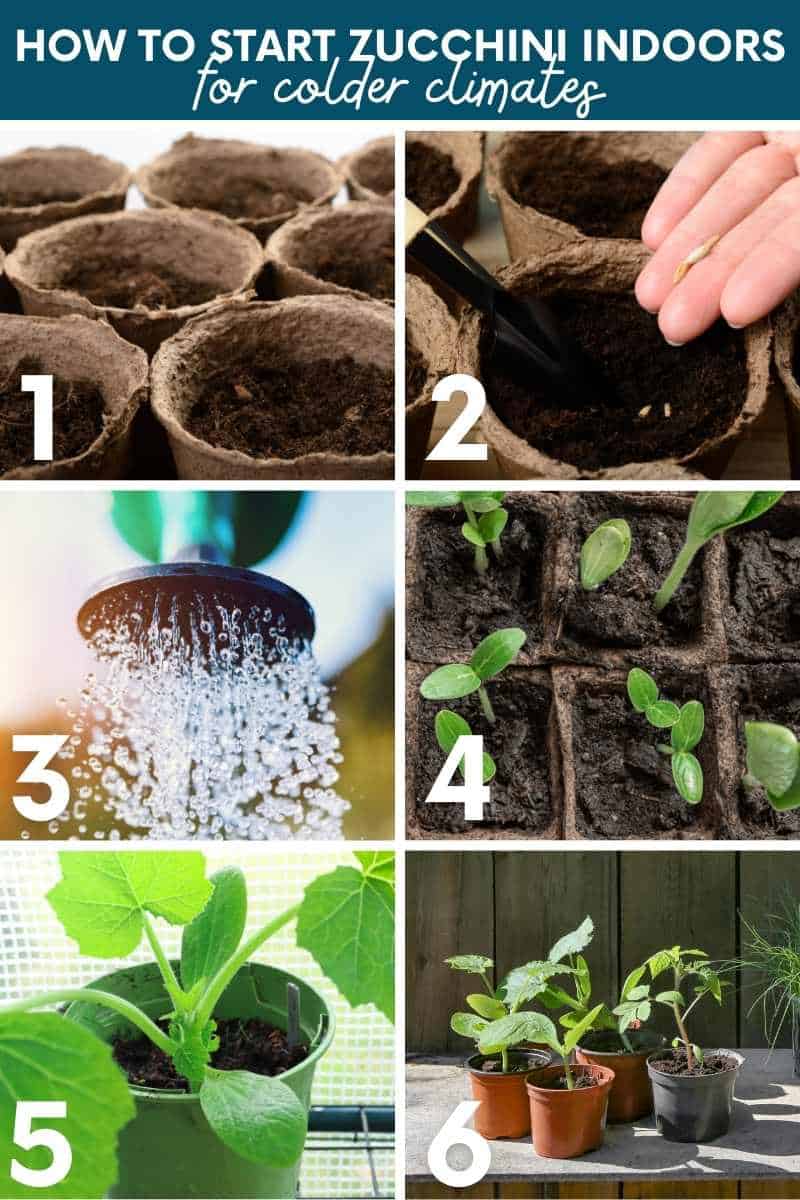
- Fill a small pot or another growing vessel with sterile seed starting mix (we like a mix of four parts coco coir, two parts compost, and one part perlite). Select a growing vessel that will leave the roots undisturbed as much as possible to avoid transplant shock later.
- Sow 2-3 seeds about 1″ deep in each pot.
- Water gently with a mister or sprayer, and keep the soil evenly moist until the seeds have germinated.
- Place the seeds in an area where the temperature stays very warm—between 80-85°F for the quickest germination. You should see some seeds popping up within 5-7 days.
- Once seedlings have sets of true leaves, thin the seedlings down to one per cell using scissors or snips.
- After the plants have 2-4 sets of true leaves, harden off the zucchini plants and transplant them outside.
Where should I plant zucchini?
Plant zucchini in an area with full sun. Pick a site that gets at least six to eight hours of sunlight a day. Ensure the soil is well-drained and rich in nutrients, with a soil pH of 6.0-7.5. Before planting, mix in some well-rotted compost or manure to ensure proper nutrients throughout the growing season. You can also plant zucchini in large containers if you don’t have enough room in your garden.
Growfully Protip
If possible, it’s best to prepare your soil the fall before by mixing in chopped leaves and compost before covering the ground with some thick mulch. In the spring, remove the mulch.
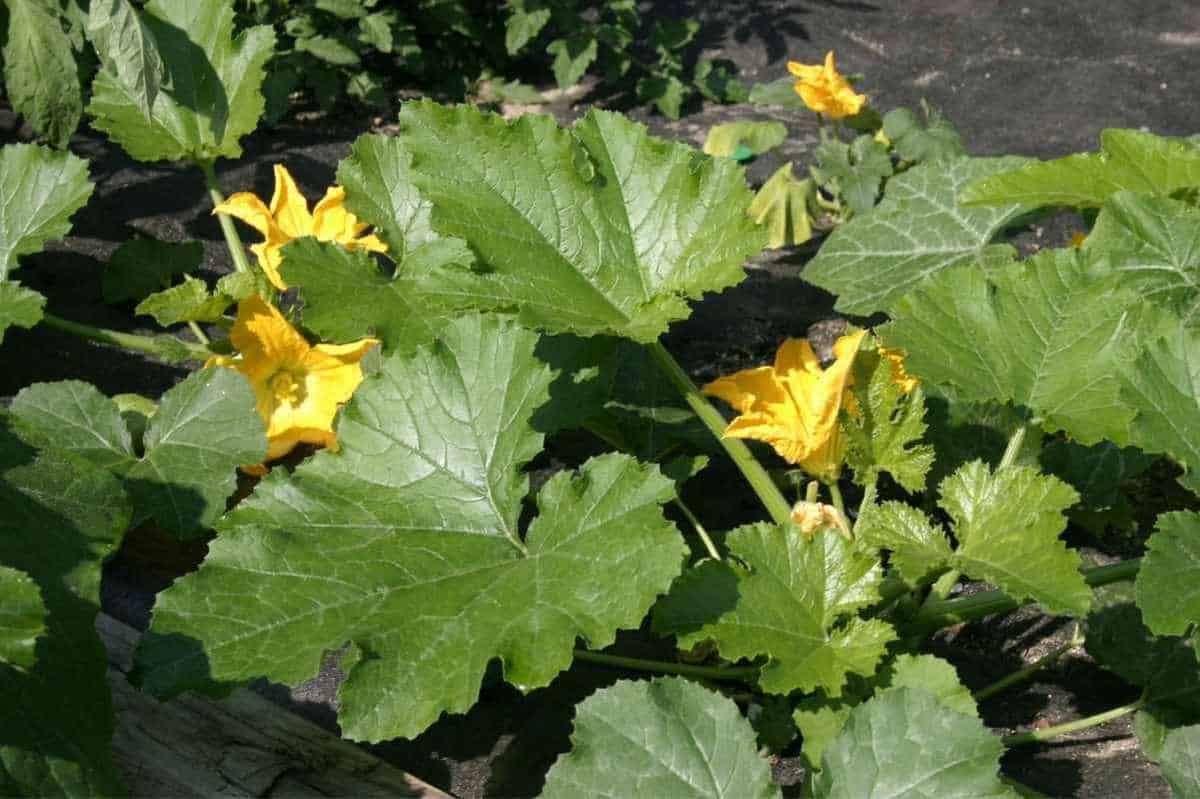
Best conditions for growing zucchini
Zucchini is a warm-weather crop that does best during the long, hot summer days. The soil needs to be at least 70°F for zucchini seeds to germinate. Zucchini requires an inch of water a week during cooler days and an inch of water every few days during hot, dry days. Since it has such a short growing season, you can grow zucchini in almost every gardening zone.
Growfully Protip
Zucchini and summer squash despise cold spells—so only plant after all danger of frost has passed. If the temps are forecasted to drop below about 50°F, you might want to consider covering your zucchini plants with a floating row cover or cloche to keep them warm. The low temps won’t kill the plants, but they will greatly slow their growth.
How long does it take to grow zucchini?
Zucchini are quick-growing plants. Different varieties have different growing times; however, you will have fresh zucchini 35 to 55 days after germination for many varieties. To ensure your zucchini grows as quickly as possible, ensure that your soil has warmed to at least 70°F before planting your seeds. If soil temperatures are too cool, it can slow germination and plant growth.
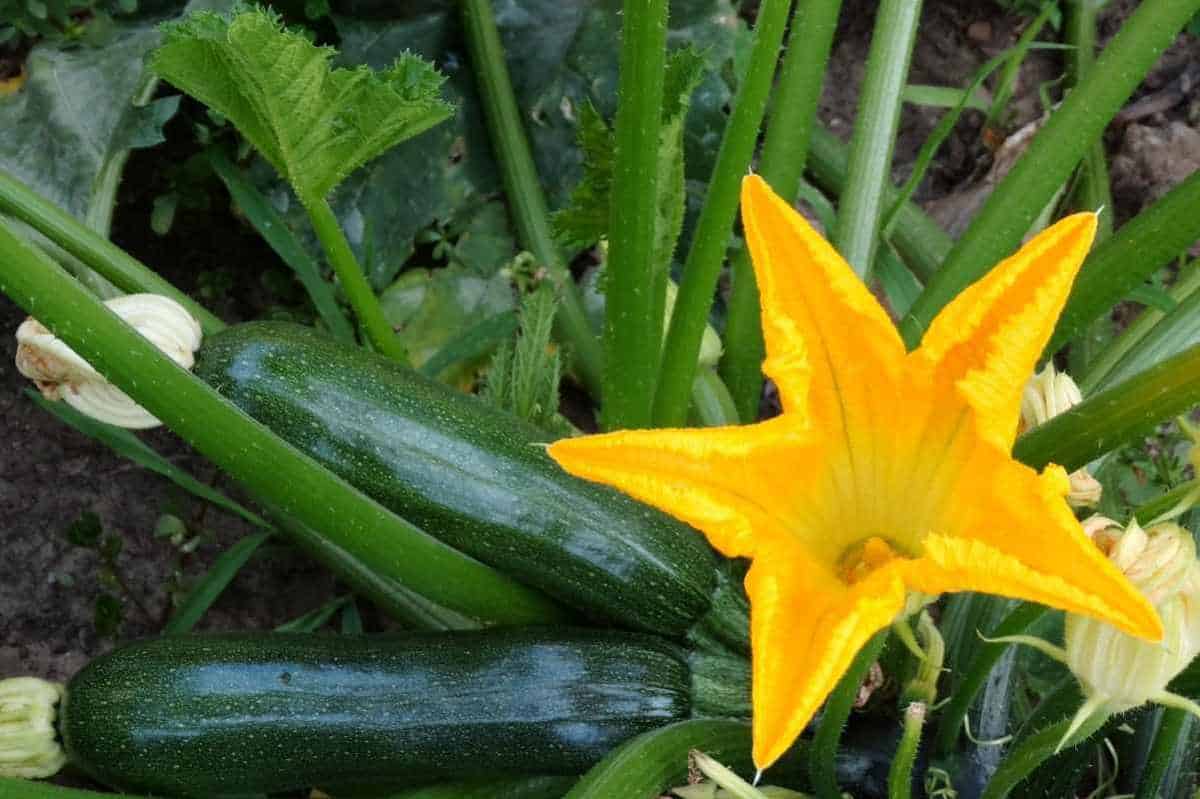
In what month do I plant zucchini?
Direct sow your zucchini outdoors as soon as the soil warms to at least 70°F. This is in late spring to early summer for most of us—about two weeks after the last frost date.
How to direct sow zucchini from seed in the garden:
Zucchini grows best when you directly sow the seeds into the garden in the spring (plus it saves you a step!). It grows so quickly that unless you live in the far Northern regions of the country, you’ll have a long enough growing season to direct sow zucchini plants.
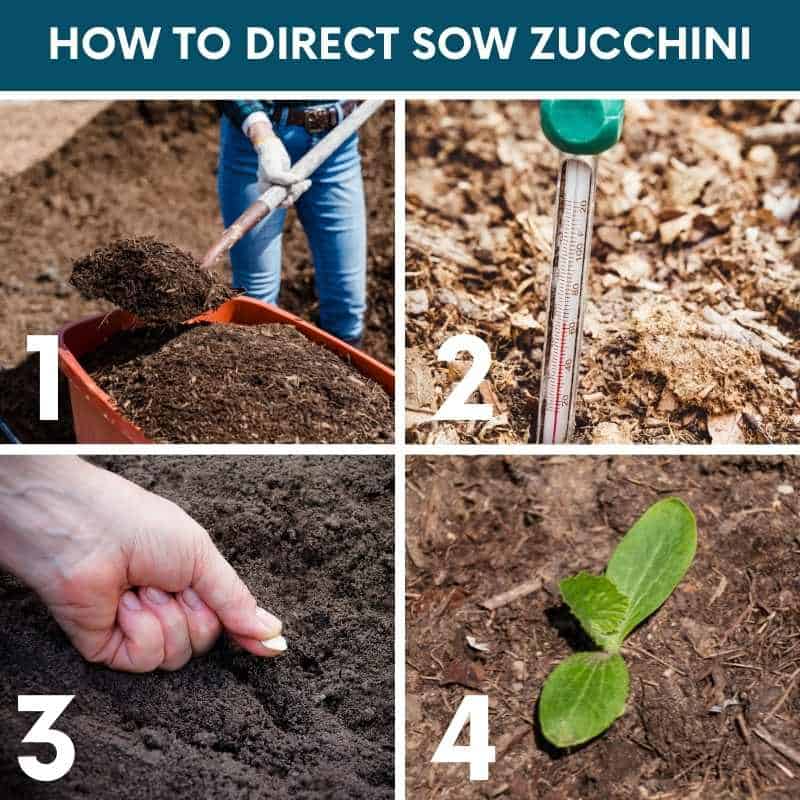
- Prepare the soil. Work well-aged compost, manure, or fertilizer into the ground. Work the manure into the first foot of soil. If using compost, lay down an inch and work it into the top inch of earth. Ensure your location gets six to eight hours of sunlight a day and has well-drained soil.
- Warm the soil. When direct sowing zucchini seeds—especially in cooler climates—it’s a good idea to warm up the soil in advance using a piece of black plastic or dark landscape cloth. This ensures that your zucchini seeds have the proper soil temperature of at least 70°F for germination. You can skip this step if you’ve waited until early summer to plant your zucchini.
- Plant seeds or set out transplants when the soil has warmed to at least 70°F. Space your bush variety plants about 18″ apart—vining varieties will need much more space (check your seed packet to know how much).
- Thin the seedlings. Once the seedlings have reached a few inches tall and they have several sets of true leaves, snip off the weaker seedlings, leaving one plant per spot. It’s important to snip the seedling at the base of the plant instead of pulling it. Yanking out your seedlings can damage the remaining plant’s roots.

How do I care for my growing zucchini?
Growing zucchini is relatively easy. Zucchini plants don’t require any special treatment as they grow. We recommend adding a nice layer of organic mulch around the plants to help retain moisture and keep weeds at bay.
Download Printable Zucchini and Summer Squash Growing Guide »
Watering zucchini
When the air temperatures are still cool during the early spring and summer months, your zucchini seedling will need roughly an inch to two inches of water per week. Increase this to an inch or two of water three times a week as the season goes on and air temperatures rise.
It’s best to water zucchini in the morning, so any moisture that accumulates on the leaves can evaporate in the sunlight. Avoid overhead watering with zucchini because water on the leaves encourages disease and pests. Instead, water the base of your zucchini plant directly.
Growfully Protip
Don’t be surprised if your zucchini and summer squash plants wilt during the heat of the day in the summer—they’ll rebound quickly once watered.
Weeding zucchini
Use a thick layer of mulch around zucchini plants to cut down on the amount of weeding you need to do throughout the season. When weeds pop up, make sure to remove them when small to avoid the weeds from crowding the plants.
Fertilizing zucchini
Zucchini and summer squash are heavy feeders. If you have rich soil, you might be able to get away without adding fertilizer, but we’ve had better squash production if we stick to a regular feeding schedule. We use a biweekly fish emulsion and kelp liquid fertilizer in the Growfully Gardens. If you notice the leaves of your zucchini getting yellow or your plants looking frail, we recommend increasing your fertilizing schedule to once a week and using a higher concentration of fish emulsion and kelp. Avoid using a high nitrogen fertilizer because this will encourage foliage growth and slow down fruit production.
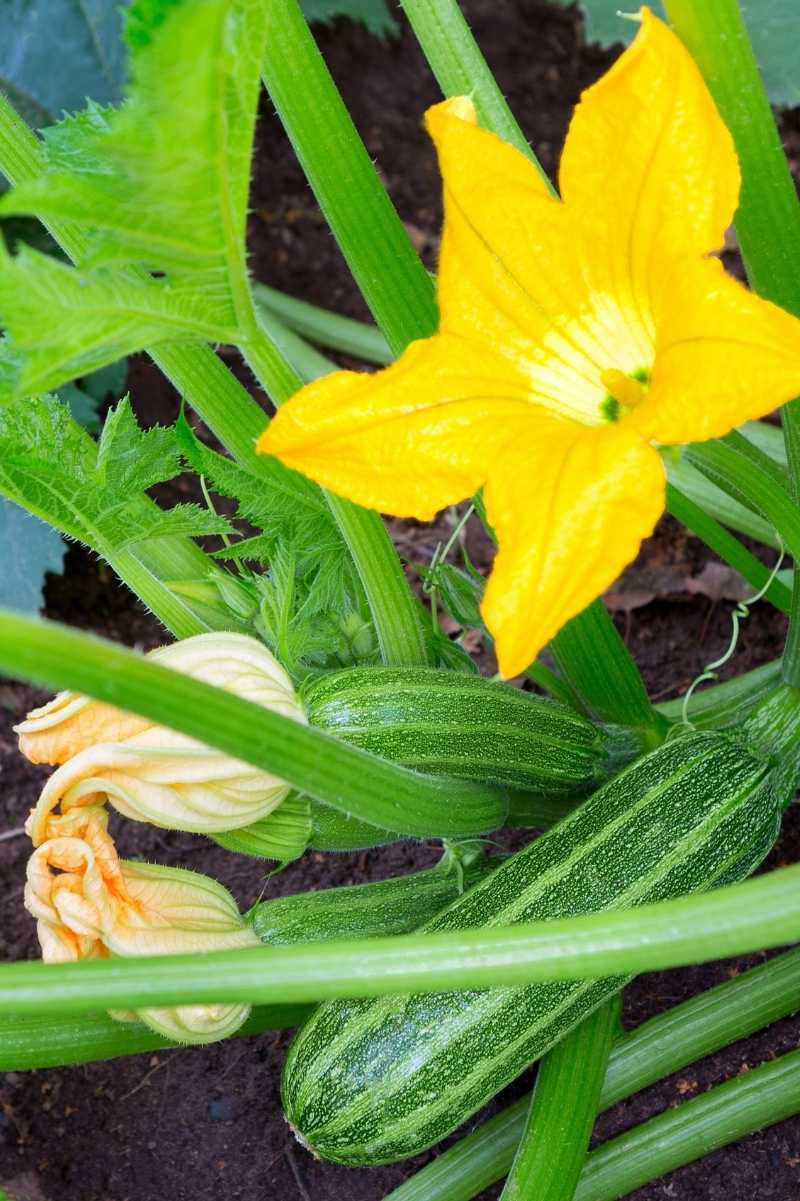
How many zucchinis will I get per plant?
Short answer, a ton! Zucchini are some of the most prolific plants you can grow in your garden. On average, a zucchini plant will produce new zucchini to harvest every day or two after it has reached maturity. You can expect to get upwards of ten pounds of fruit from a single plant!
Growfully Protip
We recommend one to two zucchini plants per family—any more than that, and you’ll be drowning in zucchini!
Growing zucchini in containers
Compact bush variety zucchini are excellent candidates for container gardening. Most people only need a plant or two of zucchini because they produce so much fruit.
When container gardening zucchini, plant three seeds to a pot and thin to one plant after the seedlings reach a few inches in height. Thin your plants by cutting the stem near the soil’s surface instead of pulling the plant. This makes sure the remaining plant’s roots aren’t disturbed.
Choose a large pot—at least two feet wide and a foot deep—and make sure it has good drainage.
Growfully Protip
You’ll need to water your zucchini more frequently if it’s grown in a container, so make sure it’s getting a good dose of water every time the first few inches of soil feel dry.
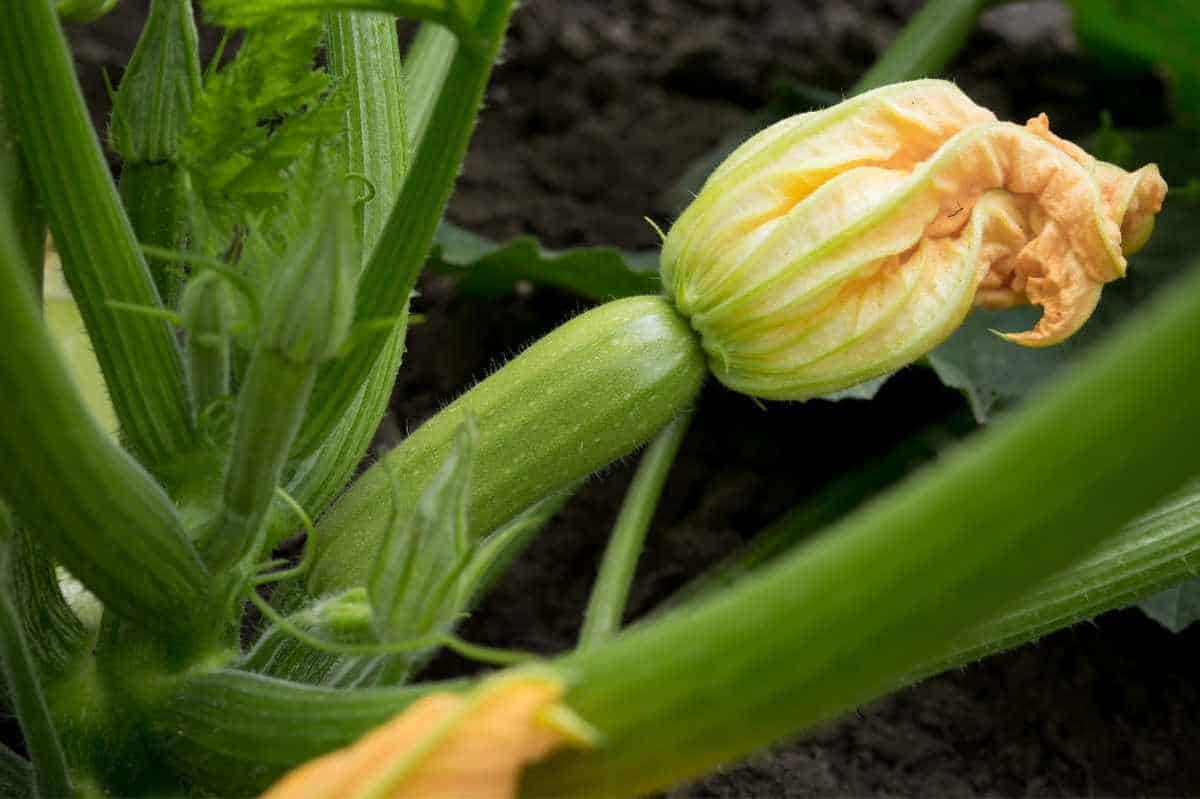
Does zucchini need a trellis?
Most zucchini plants are compact bush varieties that don’t require a trellis. However, some are vining varieties that will require support or enough space to sprawl—you can figure this out by checking your seed packet.
Can zucchini and summer squash cross-pollinate?
It’s a common myth that planting two summer squash plants near each other will result in cross-pollination and weird hybrid squash. While yes, the two varieties can cross-pollinate, the results won’t show unless you save the seeds from this year’s fruits and plant them next year—the weird hybrids will show up in the next generation.
Do I need more than one zucchini plant for pollination?
Another zucchini myth we are busting—you don’t need more than one summer squash or zucchini plant for proper pollination. Zucchini plants are monoecious, meaning they have both male and female flowers. If you have good pollinator populations, you’ll get plenty of zucchini from just one plant—although having two or more will increase your production (maybe too much—you’ll be swimming in squash).
Growfully Protip
If you have low pollinator populations, first of all, consider planting a pollinator garden to increase your bees, butterflies, and other beneficial insects. Secondly, you can consider hand-pollinating your summer squash plants. Just snap off one of the male flowers (the flowers with no mini squash on the stem) and rub the stamen with the pollen onto the pistil of the female flowers (the ones with the mini squash on the branch). Voila! You just did the work of a bee.

Do I need to use crop rotation for zucchini and summer squash?
Avoid planting zucchini in an area where you had squash, cucumbers, melons, or pumpkins the previous year. Pests and diseases can overwinter in the soil and harm your zucchini plant if you don’t rotate your crops.
Zucchini and summer squash are moderate to heavy feeders, so after harvesting your zucchini, follow it with a member of the legume family, such as beans or peas, to help fix nitrogen back into the soil. You can plant peas after zucchini for a fall harvest. Vetch and clover are perfect for planting in the fall or early spring to add nutrients back into the soil.
What are the best companion plants for zucchini?
Zucchini grows well with a variety of plants. Some plants help balance the soil nutrients, while others attract beneficial insects or repel pests. Here are some of the best companion plants for zucchini.

- Peas. Peas help fix nitrogen in the soil to help feed zucchini and summer squash. The timing also works out—plant peas in late winter or early spring growing up a fence or trellis, and then plant your zucchini in front of the peas. The peas will be producing and start to wrap up just about the time the zucchini goes in and starts producing.
- Borage attracts bees, which help pollinate your zucchini plant.
- Dill—especially flowering dill—attracts beneficial insects that help with pollination and natural predators that suppress the population of pests.
- Nasturtiums a short distance away from your zucchini can attract insects away from your plants.
- Marigolds have a strong scent that can confuse and repel certain insects.
- Garlic has a sulfur component that helps repel insects.
- Oregano repels cabbage moths and other pests with its powerful scent.
- Mints have a strong scent that helps repel and confuse insects. Flowering mints are favorites of pollinators. Just be aware that all mints are invasive—if you’d like to companion plant mint, plant it in a container, and place the pot near your zucchini plants.
- Rosemary’s potent scent repels many insects.
Growfully Protip
It’s also important to know which plants make bad companions. Do not plant zucchinis near other cucurbits—the same diseases and pests can spread between different species in the same family.
Troubleshooting Zucchini: Pests and Disease
Zucchini plants are susceptible to the same pests and diseases as most summer squash. A bit of prevention goes a long way in avoiding problems. Rotate your crops to prevent pests from overwintering and clean up all of your garden debris. Choose resistant varieties of zucchini plants if you know a particular pest or virus is common in your area. Watering at the base of the plant and using mulch can also help avoid diseases.
Growfully Protip
Don’t be alarmed if you see the first few flowers on your zucchini plant blacken and fall off. The first flowers that arrive on a zucchini plant are male flowers—they are there to attract pollinators. Then the female flowers will start to open. The male flowers will continue to fall off after doing their job.
Zucchini pests:
Pests are far and away the most significant issue most folks have when growing zucchini. In fact, in some areas, you can guarantee you’ll see a pest infestation at some point in the growing season. The good news is that zucchini and summer squash grow so fast that even if you get walloped by pests, you’ll still get tons of fresh veggies off the plant.
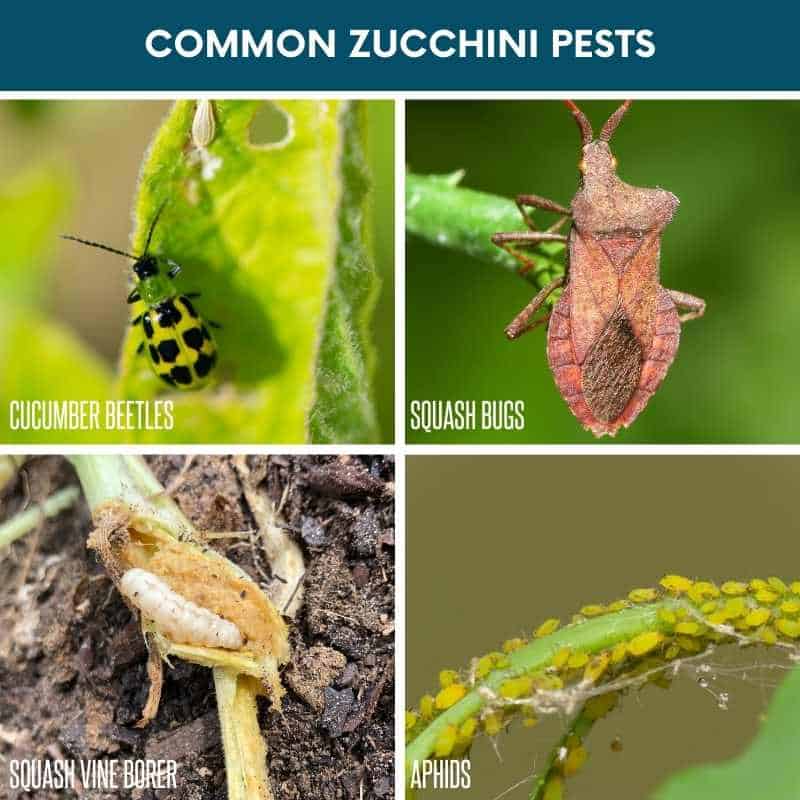
- Cucumber beetles. Both the striped and spotted types of this insect leave holes in your plants while stunting their growth. Cucumber beetles may also cause bacterial wilt.
- Squash bugs. A large insect with a flat back, squash bugs are hard to remove once established. They inject the leaves of plants with a toxin before sucking the sap from them. Check out my post on how to get rid of squash bugs organically for tips on handling this pest.
- Squash vine borers. The larvae of orange and black hummingbird moths, squash borers create large holes in the stems of zucchini plants. Using a row cover in early spring can help prevent these damaging pests. You can also wrap the base of your zucchini plant stem in aluminum foil. Prevention is the key with squash vine borers. Once they get established, they hide inside the plant’s stem, making it difficult to get rid of them without eliminating the plants.
- Aphids. A common garden pest, aphids are tiny bugs that cause yellowed leaves, misshapen fruit and flowers, and reduced harvests. They leave behind a sticky “honeydew” coating as they eat your plant. Beneficial insects such as ladybugs, parasitic wasps, and lacewings can help control aphid populations. Nasturtium can attract the aphids away from your plants, while catnip repels the insects. Once you have an aphid infestation, a water and dish soap solution or a sprinkling of diatomaceous earth can help eliminate the pests.

Zucchini diseases:
In general, zucchini and summer squash are pretty resistant to most garden diseases. While several diseases will attack them, through a few prevention techniques and choosing resistant zucchini varieties, you can help avoid losing your crop to disease.

- Blossom End Rot looks like dark spots on the end of the zucchini opposite the stem. Over time, these spots may get bigger and appear sunken. Inconsistent watering that leads to a calcium deficiency at the end of the fruit is what causes blossom end rot, so make sure your soil doesn’t dry out. When you do water, water deeply. If you still struggle with blossom end rot, you might want to increase the calcium deposits in your soil by adding bone meal or ground up eggshells.
- Mosaic Virus causes yellow, white, and green mottling on leaves. It can lead to warty, distorted fruit. The only way to get rid of mosaic virus is to destroy the affected plants before it can spread. Prevention is the key, so look for zucchini varieties that are resistant to the virus, and always make sure your tools and garden are clean.
- Powdery Mildew leaves a white coating on the top side of the leaves and looks like flour. Powdery mildew is a slow-moving disease that might take an entire season to kill a plant, so it’s not exactly an emergency—even though it doesn’t look the best. To avoid, choose resistant varieties and always make sure there’s enough air circulation around plants so sunlight can evaporate any water that might cling to damp areas. Avoid watering from above. You can apply an organic fungicide to help reduce or slow the spread—although it’s tough to eliminate powdery mildew once you have it.
Growfully Protip
Some zucchini and summer squash varieties naturally have mottled or striped leaves that can look very similar to how certain diseases present (especially powdery mildew). Check your seed packet and seed catalog photos to see how your zucchini leaves are supposed to look before treating.
When is zucchini ready to harvest?
Typically, once you see your zucchini reach six inches, it’s time to pick them—although some zucchini and summer squash can be harvested smaller or larger (check your seed packet). Left on the vine, zucchini will continue to grow until they reach enormous lengths; however, they don’t taste as good when they’re huge. They tend to get bitter, pithy, and have huge seeds (not great for humans, but the chickens love them!). Make sure you pick your zucchini frequently to encourage the plant to continue producing fruit. Once you begin harvesting zucchini, you can expect new fruit every few days.
To harvest zucchini, cut through the stem an inch or two away from the fruit. You want to avoid twisting the fruit off because this can damage both the fruit and the plant. Instead, use a sharp knife, garden scissors, or pruners to slice neatly through the stem.
Growfully Protip
Want to harvest zucchini blossoms for stuffing and frying? Go right ahead! Harvest blossoms right after they open first thing in the morning. Try to harvest mostly male blossoms—as harvesting those won’t slow your plants’ production. Just make sure to keep some of the male blossoms on for good pollination.
How do you store zucchini?
You can store zucchini in both the fridge and the freezer. If you leave them on the counter at room temperature, they’ll last for two to three days.
Zucchini will keep in the fridge for one to two weeks. Store it in a paper or plastic bag with one end left open—or in our favorite method, a damp terrycloth veggie bag. The open end allows for proper air circulation. Make sure the zucchini stays dry and keep it in the crisper drawer of your fridge.
You can freeze zucchini in coins, shreds, or zucchini noodles for longer-term storage.
Download Printable Zucchini and Summer Squash Growing Guide »

Growing Zucchini (and Summer Squash)
Materials
- Zucchini or summer squash seeds
Tools
- Fish emulsion and kelp liquid fertilizer
Instructions
- Water deeply and regularly. Compared to their size, summer squash plants tend to have shallow roots and need deep, even, regular watering to produce healthy fruits. Inconsistent or shallow watering can cause a calcium deficiency at the end of the fruits known as blossom end rot.
- Keep an eye on pests. Depending on your area, squash bugs, squash vine borers, or even cucumber beetles might take hold of your zucchini plants. Check your plants daily for signs of pest damage, eggs, or adult bugs—and destroy any you find.
- Pollinators are your friends. You need bees, butterflies, and other pollinators to carry the pollen from the male flowers to the female flowers on zucchini plants. Increase pollinator populations by growing pollinator friendly flowers nearby.
- Harvest small and regularly. Zucchini and summer squash taste best when on the smaller side. Harvest regularly to keep the plant producing.
- One or two is probably all you need. Most zucchini and summer squash varieties are incredibly prolific—planting more than one or two for a small family will have you swimming in squash!
- Feed well. Squash plants are heavy feeders, so apply fish emulsion and kelp liquid fertilizer regularly throughout the season for the best harvest.
Notes
Zucchini and summer squash hate cold snaps, so plant it out after all danger of cold has passed. If the forecast catching you out, cover the plants with floating row covers or cloches.


